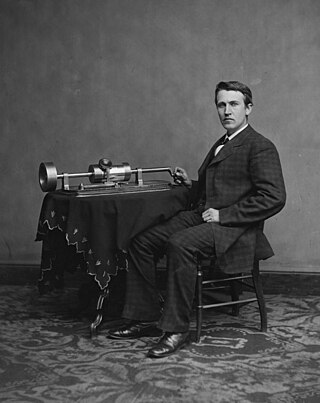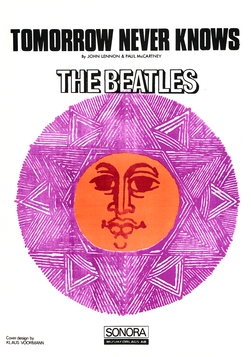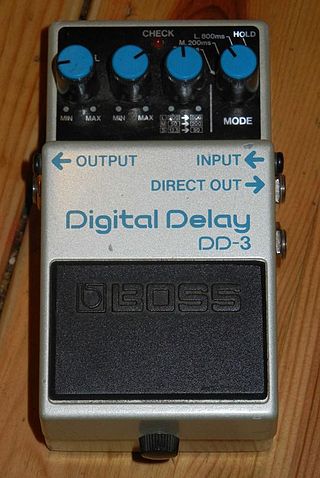Related Research Articles

An effects unit, effects processor, or effects pedal is an electronic device that alters the sound of a musical instrument or other audio source through audio signal processing.

A phonograph, later called a gramophone, and since the 1940s a record player, or more recently a turntable, is a device for the mechanical and analogue reproduction of recorded sound. The sound vibration waveforms are recorded as corresponding physical deviations of a spiral groove engraved, etched, incised, or impressed into the surface of a rotating cylinder or disc, called a "record". To recreate the sound, the surface is similarly rotated while a playback stylus traces the groove and is therefore vibrated by it, very faintly reproducing the recorded sound. In early acoustic phonographs, the stylus vibrated a diaphragm which produced sound waves which were coupled to the open air through a flaring horn, or directly to the listener's ears through stethoscope-type earphones.

An audio tape recorder, also known as a tape deck, tape player or tape machine or simply a tape recorder, is a sound recording and reproduction device that records and plays back sounds usually using magnetic tape for storage. In its present-day form, it records a fluctuating signal by moving the tape across a tape head that polarizes the magnetic domains in the tape in proportion to the audio signal. Tape-recording devices include the reel-to-reel tape deck and the cassette deck, which uses a cassette for storage.

Scratching, sometimes referred to as scrubbing, is a DJ and turntablist technique of moving a vinyl record back and forth on a turntable to produce percussive or rhythmic sounds. A crossfader on a DJ mixer may be used to fade between two records simultaneously.

Mastering, a form of audio post production, is the process of preparing and transferring recorded audio from a source containing the final mix to a data storage device, the source from which all copies will be produced. In recent years, digital masters have become usual, although analog masters—such as audio tapes—are still being used by the manufacturing industry, particularly by a few engineers who specialize in analog mastering.

In music, tape loops are loops of magnetic tape used to create repetitive, rhythmic musical patterns or dense layers of sound when played on a tape recorder. Originating in the 1940s with the work of Pierre Schaeffer, they were used among contemporary composers of 1950s and 1960s, such as Éliane Radigue, Steve Reich, Terry Riley, and Karlheinz Stockhausen, who used them to create phase patterns, rhythms, textures, and timbres. Popular music authors of 1960s and 1970s, particularly in psychedelic, progressive and ambient genres, used tape loops to accompany their music with innovative sound effects. In the 1980s, analog audio and tape loops with it gave way to digital audio and application of computers to generate and process sound.

Reel-to-reel audio tape recording, also called open-reel recording, is magnetic tape audio recording in which the recording tape is spooled between reels. To prepare for use, the supply reel containing the tape is placed on a spindle or hub. The end of the tape is manually pulled from the reel, threaded through mechanical guides and over a tape head assembly, and attached by friction to the hub of the second, initially empty takeup reel. Reel-to-reel systems use tape that is 1⁄4, 1⁄2, 1, or 2 inches wide, which normally moves at 3+3⁄4, 7+1⁄2, 15 or 30 inches per second. Domestic consumer machines almost always used 1⁄4 inch (6.35 mm) or narrower tape and many offered slower speeds such as 1+7⁄8 inches per second (4.762 cm/s). All standard tape speeds are derived as a binary submultiple of 30 inches per second.

"Money" is a song by English rock band Pink Floyd from their 1973 album The Dark Side of the Moon. Written by Roger Waters, it opened side two of the original album. Released as a single, it became the band's first hit in the United States, reaching number 10 in Cash Box magazine and number 13 on the Billboard Hot 100.
"Revolution 9" is a sound collage from the Beatles' 1968 self-titled double album. The composition, credited to Lennon–McCartney, was created primarily by John Lennon with assistance from Yoko Ono and George Harrison. Lennon said he was trying to paint a picture of a revolution using sound. The composition was influenced by the avant-garde style of Ono as well as the musique concrète works of composers such as Edgard Varèse and Karlheinz Stockhausen.

"Tomorrow Never Knows" is a song by the English rock band the Beatles, written primarily by John Lennon and credited to Lennon–McCartney. It was released in August 1966 as the final track on their album Revolver, although it was the first song recorded for the LP. The song marked a radical departure for the Beatles, as the band fully embraced the potential of the recording studio without consideration for reproducing the results in concert.

"Flying" is an instrumental recorded by the English rock band The Beatles which first appeared on the 1967 Magical Mystery Tour release. It is one of the few songs credited to all four members of the band: John Lennon, Paul McCartney, George Harrison and Ringo Starr.

Sound recording and reproduction is the electrical, mechanical, electronic, or digital inscription and re-creation of sound waves, such as spoken voice, singing, instrumental music, or sound effects. The two main classes of sound recording technology are analog recording and digital recording.
Merzbox is a box set compilation by the Japanese noise musician Merzbow. It consists of 50 CDs spanning Merzbow's career from 1979 to 1997. 30 discs are taken from long out of print releases, while 20 are composed mainly of unreleased material. The box also contains two CD-ROMs, six CD-sized round cards, six round stickers, a poster, a black long-sleeve T-shirt, a medallion, and the Merzbook, all packaged together in a "fetish" black rubber box. It is limited to 1000 numbered copies. A Merzbox Sampler was released in 1997.
The history of sound recording - which has progressed in waves, driven by the invention and commercial introduction of new technologies — can be roughly divided into four main periods:

Delay is an audio signal processing technique that records an input signal to a storage medium and then plays it back after a period of time. When the delayed playback is mixed with the live audio, it creates an echo-like effect, whereby the original audio is heard followed by the delayed audio. The delayed signal may be played back multiple times, or fed back into the recording, to create the sound of a repeating, decaying echo.
"1983… " is a song recorded in 1968 for the third studio album, Electric Ladyland, by the Jimi Hendrix Experience. Written and produced by Jimi Hendrix, the song features flute player Chris Wood of the band Traffic, and at over 13 minutes in duration is the second longest track released by the group.
"Are You Experienced?" is the title track from the Jimi Hendrix Experience's 1967 debut album. It has been described as one of Jimi Hendrix's most original compositions on the album by music writer and biographer Keith Shadwick. The song is largely based on one chord and has a drone-like quality reminiscent of Indian classical music. It features recorded guitar and drum parts that are played backwards and a repeating piano octave. Live recordings from 1968 are included on The Jimi Hendrix Concerts album and Winterland box set.

"Reflections of My Life" was a 1969/1970 hit single for the Scottish band, Marmalade. It was written by their lead guitarist Junior Campbell and singer Dean Ford. Released in late 1969, it was the band's first release on Decca following an earlier spell at CBS.
Backmasking is a recording technique in which a message is recorded backward onto a track that is meant to be played forward. It is a deliberate process, whereas a message found through phonetic reversal may be unintentional.

Electric music technology refers to musical instruments and recording devices that use electrical circuits, which are often combined with mechanical technologies. Examples of electric musical instruments include the electro-mechanical electric piano, the electric guitar, the electro-mechanical Hammond organ and the electric bass. All of these electric instruments do not produce a sound that is audible by the performer or audience in a performance setting unless they are connected to instrument amplifiers and loudspeaker cabinets, which made them sound loud enough for performers and the audience to hear. Amplifiers and loudspeakers are separate from the instrument in the case of the electric guitar, electric bass and some electric organs and most electric pianos. Some electric organs and electric pianos include the amplifier and speaker cabinet within the main housing for the instrument.
References
- ↑ Kittler, Friedrick. "The Gramophone". Adventures in CyberSound. Australian Centre for the Moving Image. Archived from the original on 2004-03-02. Retrieved 2007-03-01.
- ↑ Kittler, Friedrick. "The Gramaphone". Archived from the original on 2004-03-03. Retrieved 2007-03-01.
- ↑ Blecha, Peter (2004). Taboo Tunes: A History of Banned Bands & Censored Songs . Hal Leonard. p. 48. ISBN 978-0-87930-792-9.
- ↑ White, Ray. "Musique Concrète". whitefiles.org. Archived from the original on November 18, 2007. Retrieved 2007-11-05.
- ↑ Peters, Michael. "The Birth of Loop: A Short History of Looping Music". loopers-delight.com. Archived from the original on March 28, 2007. Retrieved 2007-03-10.
- ↑ 20 Things You Didn't Know About The Beatles' 'Revolver', NME, 2016-08-03